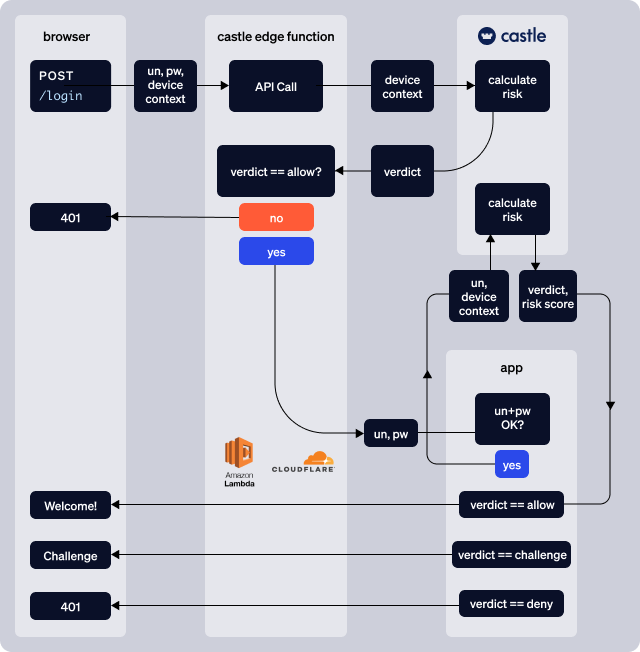Edge functions
Overview
Castle provides code samples that allow you to deploy the Castle risk engine into your edge solution.
For more information about why you might want to deploy Castle both at the edge and in-app, see the blog post A Layered Approach to Bot Detection and ATO prevention.
Code samples are available for Cloudflare and for AWS CloudFront/Lambda@Edge. If you are using another edge/CDN solution, you should be able to modify the code samples to fit your needs.
This diagram shows a high-level overview of how Castle works at each layer.

a diagram showing the flow of request data with a Castle Edge integration
Example Implementations
To get started quickly, please check out these code samples, which implements Castle in common Edge environments.
Steps
Step 1. Set up edge listeners in your CDN
Set up Castle at the edge to listen for requests on endpoints typically targeted by attackers, for instance /register or /login. This would be configured in your CDN.
Step 2. Capture request tokens
Requests to Castle must contain a request token, which is generated by Castle's JavaScript or Mobile SDK's that you will need to integrate separately from the CDN function. The request token value can be sent from the frontend to the edge as a cookie, header, or form field - the implementation is left to you. In the code samples, it's expected to be passed as a castle_request_token parameter.
See our tutorials on client-side integration] for details.
Step 3. Send Castle API requests
Once a valid Castle request token is present in requests at the edge, and the relevant endpoints have listeners set up, send requests to the Castle API every time one of your watched endpoints receives a request.
Step 4. React to the Castle verdict
When a request arrives at one of the integrated endpoints, the sample code will send the context of the request to Castle, and get a recommended verdict (and risk score) in return. If the recommended verdict is “deny”, then you can reject the request at the edge, without the request ever hitting your application. If the recommended verdict is “allow”, then you can allow the request to proceed to your application for further processing.
Updated about 1 month ago